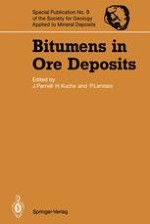1993 | OriginalPaper | Chapter
Organic Matter (Bitumen and Other Forms) as the Key to Localisation of Mississippi Valley-Type Ores
Authors : C. S. Spirakis, A. V. Heyl
Published in: Bitumens in Ore Deposits
Publisher: Springer Berlin Heidelberg
Included in: Professional Book Archive
Activate our intelligent search to find suitable subject content or patents.
Select sections of text to find matching patents with Artificial Intelligence. powered by
Select sections of text to find additional relevant content using AI-assisted search. powered by
The restriction of a variety of minerals and alteration effects of Mississippi Valley-type ores to specific sites within huge volumes of potential host rock suggests that some peculiar characteristic of the sites caused them to become the focus of mineralisation. We propose that the ores were localised where a hot (80–220 °C) brine bearing thiosulphate (S2O32−) and metals interacted with organic matter. By acting as a reductant, a source of organic acid, a source of CO2, and a substrate for bacterial metabolism, organic matter played a critical role in each stage of the paragenesis of Mississippi Valley-type deposits.The transport of sulphur in the form of thiosulphate inhibited the precipitation of extremely insoluble Pb and Zn sulphides and barium sulphate; thus metals and sulphur as thiosulphate could be carried in one mineralising solution. In contrast to sulphate, which is reduced so slowly at temperatures less than 230 °C that it would flush through the ore zone long before it could be reduced by organic matter, thiosulphate is readily reduced by organic matter to produce the −2 and −1 valent sulphur needed to precipitate sulphide (PbS, ZnS) and disulphide (FeS2, NiS2) minerals.Reactions induced by the heating of organic matter at the sites of mineralisation may have produced the carbonate paragenesis typical of Mississippi Valley-type ores. Prior to the sulphide stage of mineralisation, carbonates first dissolved and then precipitated; during the sulphide stage, carbonates again dissolved. The initial dissolution may have been caused by organic acids that were produced by the heating of organic matter. With continued heating to about 120 °C, the organic acids began to break down to CO2 and CH4. The addition of CO2 in the presence of organic acid pH buffers, provided by organic acids that had yet to degrade, precipitated carbonate minerals. At still higher temperatures (−140°C), organic acids quickly degraded, so the pH buffer was lost. Without a buffer, the continual addition of CO2 lowered the pH, and the carbonates dissolved. The addition of CO2 also may have triggered the precipitation of fluorite by forming MgHCO3+ and F− at the expense of MgF+.Late-stage baryte and calcite appear to have formed at temperatures low enough for bacteria to survive. Bacteria can metabolise thiosulphate in the presence of organic matter. Products of this metabolism include SO42−; and CO2; the former precipitated as baryte and the latter formed late-stage (postmain-sulphide-stage) calcite.
